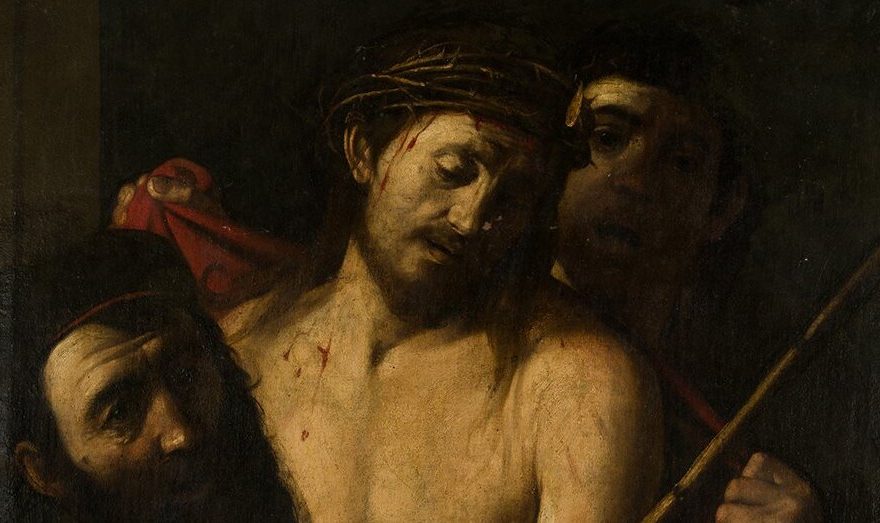They call it a “sleeper”: With a starting price of just $1,800, a potentially undervalued old master painting was pulled from auction and is now thought to be worth millions.
A sale of art and antiques at the Madrid auction house Ansorena on Thursday was scheduled to include a grimy oil on canvas of Christ being crowned with thorns, cataloged as from the “circle” of the 17th-century Spanish painter José de Ribera. The suggested starting bid was set at 1,500 euros, or about $1,800. The Museo del Prado in Madrid, which had become aware that this painting might be a long-lost work by Michelangelo Merisi da Caravaggio, the most celebrated of all Baroque artists, alerted Spain’s culture ministry. And on Wednesday, the ministry announced an export ban on the painting, and it was withdrawn from the auction the following day.
“About the authorship, the different experts are studying the work right now,” said Belén Puente Herrero, the director of communications at Ansorena, who declined to provide further details about the painting and its ownership.
Two weeks ago, the painting was spotted online by the London-based old master dealers Marco Voena and Fabrizio Moretti, who flew to Madrid to view the work in person. They believe it to be a well-documented but long-lost Caravaggio.
“When I saw it, it went ‘boom,’” said Voena, speaking in a phone interview from Madrid. “It’s Caravaggio, completely. It’s incredible. It has great power.” He added that the painting was owned by a “normal family” and that he had offered to negotiate a private sale to a Spanish museum for a “small commission,” but the auction house had yet to respond.
In 2017, Voena and Moretti bought a newly discovered self-portrait by Caravaggio’s renowned contemporary Artemisia Gentileschi for 2.4 million euros with fees, or about $2.8 million, at a Paris auction. The dealers later sold it to the National Gallery in London.
If the painting does prove to be a fully accepted Caravaggio, the Museo del Prado in Madrid, whose collection at the moment contains just one work by the artist, would be a logical new home.
“At this moment no one at El Prado has seen the painting personally,” said Carlos Chaguaceda, the communications director at the museum. “Nevertheless we consider that it deserves a deep study as soon as possible.”
The subject, from St. John’s Gospel, shows Pontius Pilate presenting the scourged and mocked Christ to the crowd. According to contemporary biographers, Caravaggio participated in a secret competition with two other painters to make a canvas of this scene, known as “Ecce Homo.” Caravaggio’s entry was reputedly taken to Spain. A painting of this subject is displayed as a Caravaggio at the Galleria Palazzo Rosso in Genoa, but the attribution has been disputed by some scholars.
Maria Cristina Terzaghi, an associate professor of art history at Roma Tre University in Rome, is among the scholars who believes that the painting withdrawn from the Madrid sale is Caravaggio’s original “Ecce Homo.”
“There is no doubt about the attribution,” said Terzaghi, who flew to Madrid on Tuesday to view the work in person.
Terzaghi said that the canvas matched the description and size of corresponding Caravaggio works listed in two 17th-century collectors’ inventories, and that the figure of Pilate was based on a model who appears in another Caravaggio work, the “Madonna of the Rosary,” now in the Kunsthistorisches Museum in Vienna.
Terzaghi said she thinks the painting was made in Naples around 1606. She added that the canvas had suffered from some paint losses and discoloration, and was “not in very good condition.”
“The problem is the provenance,” said Terzaghi, who pointed out that the painting disappears from documentation in the mid-17th century. “There are holes in the story which we need to clarify.”
The value of the painting is also a matter for clarification. The last major painting to be offered on the market as a Caravaggio was a newly discovered canvas of “Judith and Holofernes” scheduled to be sold at auction Toulouse in 2019. Estimated at €100 million to €150 million, the painting was withdrawn shortly before the sale and bought privately by the New York-based collector J. Tomilson Hill for a price closer to the reserve of €30 million. Scholars were divided over whether it was painted solely by Caravaggio.
As this latest possible rediscovery now cannot leave Spain, we will not know what it would have made if it were accepted as a Caravaggio and was offered on the international market.
But Anthony Crichton-Stuart, a former Christie’s specialist who is now director of the dealer Agnew’s, a London gallery, can hazard a guess. “If it were offered on the open market, and it had full support from a majority of scholars, I think it would be worth at least €50 million,” said Crichton-Stuart — nearly $60 million. “But how long is a piece of string?”
Source: Read Full Article
